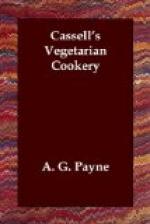BLACK CURRANT JELLY.—The juice of black currants makes excellent jelly in the ordinary way if we boil a pint of black currant juice with a pound of sugar till it sets; but a mould of black currant jelly suitable to be used as a sweet at dinner can be made by adding less sugar and thickening the juice with corn-flour, allowing about a tablespoonful to every pint, and pouring it into a mould or plain round basin. The mould can be ornamented as follows, and we will suppose a pudding-basin to be used for the purpose. We will suppose the mould of jelly to have been turned out on to a clean sheet of white paper. Pick some of the brighter green black-currant leaves off the tree, and place these round the base of the mould with the stalk of the leaf pushed underneath and the point of the leaf pointing outwards. Now choose a few very small bunches of black currants, wash these and dip them into very weak gum and water, and then dip them into white powdered sugar. They now look, when they are dry, as if they were crystallised or covered with hoar-frost. Place one of these little bunches, with the stalk stuck into the mould of jelly, about an inch from the bottom, so that each bunch rests on a green leaf. Cut a small stick of angelica and stick it into the top of the mould upright, and let a bunch of frosted black currants hang over the top. If we wish to make the mould of jelly very pretty as a supper dish, where there is a good top light, we can dip the green leaves into weak gum and water and then sprinkle over them some powdered glass.
RED CURRANT JELLY.—Red currant jelly can be made in exactly a similar manner, substituting red currants for black.
RASPBERRY JELLY.—The raspberries should be picked very ripe, and two or three dozen of the best-looking ones of the largest and ripest should be reserved for ornamenting. If possible, also gather some red currants and mix with the raspberries, on account of the colour, which otherwise would be very poor indeed. It will be found best to rub the raspberries through a hair sieve, as the addition of the pulp very much improves the flavour of the jelly. The sieve should be sufficiently fine to prevent the pips of the raspberries passing through it. The juice and pulp from the raspberries and currants can now be thickened with corn-flour as directed in the recipe for blackberry jelly. Raspberry leaves should be placed round the base of the jelly and a ripe raspberry placed on each. The best-looking raspberry can be placed on the top of the mould in the centre of two or three raspberry leaves stuck in the jelly.
APPLE JAM AND APPLE JELLY.—The following recipe is taken from “A Year’s Cookery,” by Phyllis Brown:—“The best time for making apple jelly is about the middle of November. Almost all kinds of apples may be used for the purpose, though, if a clear white jelly is wanted, Colvilles or orange-pippins should be chosen; if red jelly is preferred, very rosy-cheeked apples should be taken,




